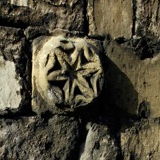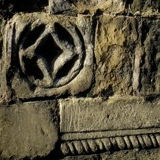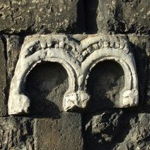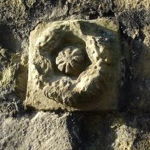



Plaque number 85 can be found at this location.
Old Sarum Stones
This plaque can be found on the Close wall next to St Ann's gate.
The O/S grid position is SU ????? East ????? North.
In the year 1331 King Edward III granted to
the Bishop and the Dean and Chapter
the stone of the walls of the Norman
Cathedral at Old Sarum for the building
of the Tower of the Cathedral and the
wall with battlements about the Close.

On this subject the great 19th century history of Wiltshire (Hoare, Benson and Hatcher) says:
‘A change of still more importance which may, in fact, be considered as the rupture of the last link connecting the old and new cities of Sarum, was the demolition of the cathedral of Osmund. This was effected in 1331 under a letter patent from the king [Edward III] on whose soil it was built. In this instrument he states that he had granted by especial favour to Robert [Wyville] the bishop and the Dean and Chapter all the walls of the former cathedral of Old Sarum and of the houses which had belonged to the bishop and canons within his castle of Sarum to hold as his gift for the improvement of the church of New Sarum and the Close thereto belonging. There is no reason to doubt that the materials obtained by the demolition of these buildings were employed in completion of the spire and the erection of a wall surrounding the Close.’
Work on the tower had probably begun under Bishop Simon of Ghent in 1315. It continued under his successor Roger Mortival, who decided to add the spire. The tower had probably been completed by 1330 when Bishop Roger died and was succeeded by Robert Wyville. As the royal grant did not take place until 1331, one author (Roy Spring) has doubted whether any material from Old Sarum was used in the tower. On this point there can be no certainty, but anyone visiting the tower will find it difficult to spot any stone identifiable as coming from Old Sarum.
In the Close wall, however, there are some fine examples of worked stone from Old Sarum, especially along Exeter Street – see photographs below.

|

|
| Close wall worked stone 1 | Close wall worked stone 2 |

|

|
| Close wall worked stone 3 | Close wall worked stone 4 |
The plaque mentions battlements. The addition of battlements (crenellations) to any form of building required the king’s permission in the form of a licence to crenellate. One such licence was issued to Salisbury in 1328: -
‘………..New Salisbury should be a free city enclosed with dikes, and whereas Roger [Mortival] the bishop, the canons and the citizens have petitioned for a licence to enclose, fortify and crenellate the said city with a wall of stone and mortar and to build proper turrets upon the wall for the safer keeping of the city in future; the king [Edward III] has granted the licence so prayed, with power to repair the said wall and turrets as needful…’
Licences to crenellate were granted to the bishop for the Close wall and for his palace.
Why build battlements? First, there was the security situation, both national and local. In 1327 King Edward II had been deposed, and in 1337 war broke out with France. In Salisbury relations between the canons and the city were sometimes bad, and the citizens in addition wanted security against incursions by robbers. There was also the matter of prestige. In the first line of the licence quoted above there is a hint that proper defences symbolised a city’s freedom and winning permission to build them would be seen as a significant ‘rite of passage’. In Salisbury’s case a complete wall was never built, but an earthen rampart and ditch (approved by the bishop as ‘lord of the soil’ in 1367) was constructed running from St Martin’s Church to the Avon at Castle Street via St Ann Street, Rampart Road, Winchester Street, Greencroft and St Edmund’s College.
As for the bishop, he was a major feudal lord holding lands from the king in return for military service. For instance, in 1229, though personally exempt, he owed the king the service (or the monetary equivalent) of 32 knights. What more natural, then, than that someone with a baron’s responsibilities should expect to live, in effect, in a castle. It also probably rankled with successive bishops of Salisbury that, until his fall from royal favour in 1139, their predecessor Roger le Poer had lived in the royal castle at Old Sarum and held castles at Sherborne, Malmesbury and Devizes – a situation that was only partly restored when Bishop Robert Wyville recovered Sherborne castle in 1355.
From the king’s viewpoint, granting a licence to crenellate was a useful way of showing royal favour, and refusal to do so might put a brake on the proliferation of castles. Angevin kings always had before them the spectre of Stephen’s reign, when ‘every lord built castles’ which he ‘filled with devils and evil men’.
The Peterborough Chronicle entry for the year 1137 (in Dickins and Wilson’s Early Middle English texts –Bowes and Bowes 1951)
The Henry III Fine Rolls entry 14/22 for 8 November 1229 concerning the aid of the archbishop and bishops (via the National Archive Office/Kings College London/Canterbury Christ Church University fine rolls project website http://www.finerollshenry3.org.uk)
The licence to crenellate of 12 April 1328 granted at Stamford by privy seal – Calendar of Charter Rolls vol 4 page 82 (via The Gatehouse website)
History of Modern Wiltshire - Hoare, Benson and Hatcher – published by John Bowyer Nichols and Son, 1843 (extract from page 83 of the volume on Salisbury quoted above)
Salisbury Cathedral – The Making of a Medieval Masterpiece. Tim Tatton –Brown and John Crook - Scala Publishers 2009.
Salisbury Cathedral – Roy Spring, Unwin Hyman 1987
Special thanks are due to Miss Suzanne Eward, Librarian and Keeper of the Muniments, Salisbury Cathedral
Click here to go back to Salisbury Plaques Home Page
Click here to go to the Salisbury Civic Society's Home Page.
Click here to check validation.